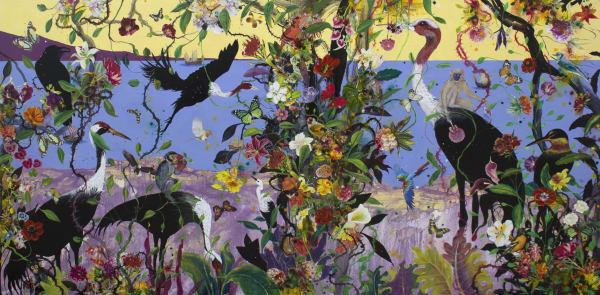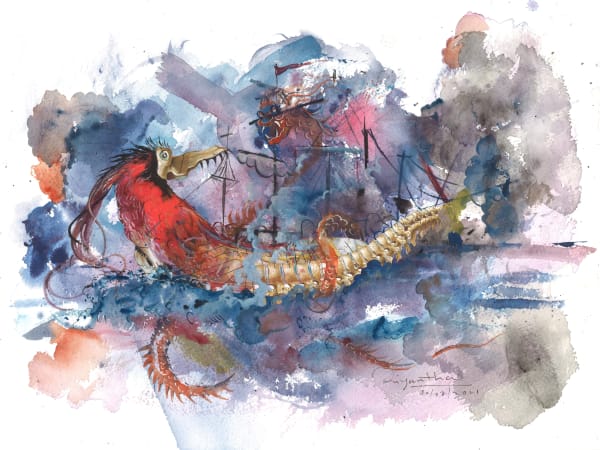Serendib: Priyantha Udagedara
An abundance of flora and fauna. A tropical ensemble of a myriad different colours and diverse forms and textures. Creatures of flight in their wingspread splendor; some perched momentarily. Beneath this camouflage, the sailing ships, the water front, colonial masters, ancient weapons and motifs, the fiery sun in its marigold magnificence. Entwining all, the silhouettes, the dark thorny maze.
In the signature piece from Serendib, the cerulean blue ocean is an enticing backdrop for the white-naped cranes, the butterflies and apes, among the multitude of flora and foliage, tropical and otherwise. Priyantha remarks that in this series of paintings, the point of view is always of the islander casting an outward glance, towards and beyond the sea.
The hallmark sailing ships dot the seafront, scenes of past invasion and occupation. The ancient ships signify the arrival of the colonial masters, seen atop hillocks in horse-mounted surveillance–the male gaze of the lone figures sizing up the hilly terrain for gainful cultivation. The artist’s canvas capturing that bare instant before the colonizer tampered with the picturesque landscape. The moment before complete invasion, and destruction of the pristine wilderness; before the aura of the fabric-paint pointillism radiating forth from the horse rider completely dominates, for monetary gain.
“Between the trees are the bushes which often knit the whole jungle together into an impenetrable tangle of thorns,” Leonard Woolf’s words resonate within the entwined whole of the landscape with its dark-hued thorns that twist and turn, piercing through the foliage, contrasting with the bright and sunny.
The colonial gaze. It is the underplayed subtext in most canvases, culminating with the centrally located gaze of Queen Victoria, camouflaged by the darkly engaging flora and fauna. The puzzle pieces of the collage of flowers rally round the Victorian gaze that attempt to thwart their blossoming. Without much success, though. Not only is the gaze partly concealed, it is subdued by the gazes of the creatures of the wild. Parallel to the half-concealed gaze, another canvas outlines the exuberant form of the queen in complete regal outfit. However the royal personage recedes further to the background with the silhouetted birds and creepers that dominate the foreground.
In this backdrop, the three depictions of oceanic vessels appear as detail—closeups of the silhouetted images in the fauna-centric collection of Serendib. The collage of neatly extracted vertebrae and the assortment of internal organs straight from a biology manual, some retaining their medical terminology within the image of the watercraft, add to the many readings of the artwork. Priyantha recalls his share of engagement with ancient and modern lore of pirates and other iconic seafarers and plundered wealth, alongside the mythical beasts, as the inspiration for the threesome of sailing-ship paintings.
It can be said that a leitmotif of Priyantha’s recent artworks is nature in its diversity that finds expression through the arranged flower gardens as well as the exotic tropical wilderness in apparent disarray. These underpinnings, is a reminder of the need to re-focus on the environment, as we look beyond the colonial gaze into our present and the future.










